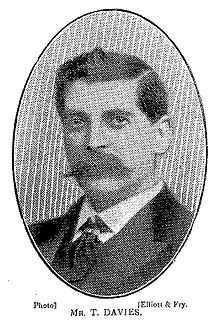Timothy Davies (politician)

Timothy Davies (22 August 1857 – 8 August 1951) was a British Liberal Party politician who was twice elected as a Member of Parliament (MP).
Timothy Davies was born in Llanpumsaint, Carmarthenshire where he spent his childhood years until later moving to Liverpool to become an apprentice in the textile industry.[1] In 1885, he founded his own company in Fulham, London but maintained strong links with Wales as evidenced when he commissioned a stone fountain for Carmarthen Park in 1899.[1]
Political career
In 1896 he was elected a member of Fulham Vestry as a Progressive. He continued as a Councillor of the new Fulham Borough Council in 1900. In 1901 he was elected Mayor of the borough council, serving from 1901-02. In 1903 he was appointed a borough Alderman. In 1901 he was elected to the London County Council as a Progressive Party candidate, gaining Fulham from the Conservative backed Moderate party. He was re-elected in 1904 and served until 1907.[2]
He was a supporter of the Temperance movement.[3] For many years he had a close friendship with David Lloyd George.[4] In 1906 he completed his hat-trick of Fulham representation when he gained the parliamentary seat at the General Election;

| 1906 General Election: Fulham | |||||
|---|---|---|---|---|---|
| Party | Candidate | Votes | % | ±% | |
| Liberal | Timothy Davies | 8,037 | 52.0 | 12.6 | |
| Conservative | William Hayes Fisher | 7,407 | 48.0 | -12.6 | |
| Majority | 630 | ||||
| Turnout | 20,620 | 74.9 | |||
| Liberal gain from Conservative | Swing | ||||
In 1910, rather than seek re-election at Fulham, he switched constituencies to contest Louth in Lincolnshire;
| General Election January 1910 Louth:
Electorate 10,315 | |||||
|---|---|---|---|---|---|
| Party | Candidate | Votes | % | ±% | |
| Conservative | Henry Langton Brackenbury | 4,433 | |||
| Liberal | Timothy Davies | 4,275 | |||
| Majority | |||||
| Turnout | |||||
| Conservative hold | Swing | ||||
Despite failure, he fought the seat again 11 months later;
| General Election December 1910 Louth:
Electorate 10,124 | |||||
|---|---|---|---|---|---|
| Party | Candidate | Votes | % | ±% | |
| Liberal | Timothy Davies | 4,260 | |||
| Conservative | Henry Langton Brackenbury | 4,188 | |||
| Majority | |||||
| Turnout | |||||
| Liberal gain from Conservative | Swing | ||||
In 1912 he voted against and in 1917 he voted in favour of giving votes to women. In 1916 he supported the introduction of Conscription. In 1918, he was absent during the key Maurice debate.[5] He sought re-election at the 1918 election but found that the Coalition 'coupon' had been issued to his Unionist opponent;
| General Election 1918: Louth | |||||
|---|---|---|---|---|---|
| Party | Candidate | Votes | % | ±% | |
| Coalition Conservative | Henry Langton Brackenbury | 9,055 | 54.5 | ||
| Liberal | Timothy Davies | 7,559 | 45.5 | ||
| Majority | 1,496 | 9.0 | |||
| Turnout | 16,614 | 60.3 | |||
| Coalition Conservative gain from Liberal | Swing | ||||
Davies did not stand for Parliament again.
As well as serving as a MP Timothy Davies also became a Justice of the Peace and an Income Tax Commissioner. He died in 1951, aged 94.
References
- Craig, F. W. S. (1983) [1969]. British parliamentary election results 1918-1949 (3rd edition ed.). Chichester: Parliamentary Research Services. ISBN 0-900178-06-X.
- ↑ 1.0 1.1 http://vads.ahds.ac.uk/large.php?pic=ahcarmarth01515&page=48&mode=boolean&words=stone&idSearch=boolean&vadscoll=Public+Monuments+and+Sculpture+Association Public Monuments and Sculpture Association: Fountain donated by Timothy Davies to Carmarthen
- ↑ Liberal Year Book 1907
- ↑ General Election 1906, Wales and Monmouthshire
- ↑ Tempestuous ~Journey by Frank Owen
- ↑ Hansard
External links
- Hansard 1803–2005: contributions in Parliament by Timothy Davies
| Parliament of the United Kingdom | ||
|---|---|---|
| Preceded by William Hayes Fisher |
Member of Parliament for Fulham 1906–1910 |
Succeeded by William Hayes Fisher |
| Preceded by Henry Langton Brackenbury |
Member of Parliament for Louth December 1910–1918 |
Succeeded by Henry Langton Brackenbury |